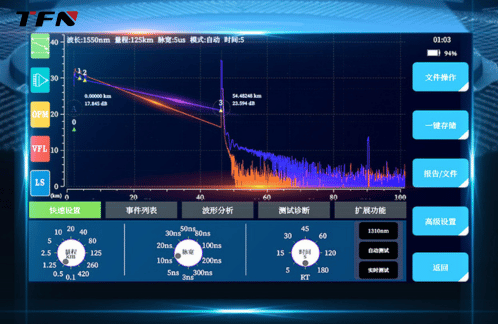How to choose the appropriate pulse width when using an optical time domain reflectometer
In optical fiber network testing, the pulse width selection of the optical time domain reflectometer (OTDR) directly affects the test accuracy and efficiency. Taking the TFN F7 model as an example, its pulse width covers 5ns to 20μs, which is suitable for different scenarios. The following analyzes the selection logic from three aspects: principle, strategy, and precautions.
1. The core influence of pulse width: dynamic range and blind area
The pulse width determines the light energy injected into the optical fiber by the OTDR, which is strongly related to three indicators:
Dynamic range and test distance: wide pulses (such as more than 1000ns) have high injection energy and strong backscattering, which is suitable for long-distance testing. TFN F7 can achieve a dynamic range of 45dB with wide pulses at a wavelength of 1550nm, supporting a range of 420km.
-
Dead zone control: narrow pulses (such as less than 50ns) can reduce event dead zones and attenuation dead zones. For example, the TFN F7's 5ns pulse event dead zone is only 0.8m, which is suitable for detecting fiber near-end connectors or dense events.

2. TFN F7 pulse width selection strategy
2.1. Match pulse width according to test distance
Short distance (<10km): select 5-200ns narrow pulse. For example, in campus network testing, 50ns pulse can take into account 0.05m ranging resolution and near-end blind zone control.
Medium and long distance (10-50km): use 200-2000ns pulse. In the metropolitan area network scenario, 1000ns pulse balances the dynamic range (40dB+) and blind zone (4m attenuation blind zone).
Ultra-long distance (>50km): requires a wide pulse of more than 2000ns. In submarine cable testing, 20μs pulse can penetrate 100 kilometers of loss to ensure that the far-end signal can be measured.
2.2. Adjust according to test accuracy and fiber type
High resolution requirements: When detecting microbends or small losses, select 5-20ns extremely narrow pulses. TFN F7's 5ns pulses are combined with four-point analysis, and the loss resolution reaches ±0.001dB.
Fiber type adaptation: For single-mode fiber, select wide pulses of more than 1000ns (such as 1310/1550nm wavelength); for multimode fiber, due to high scattering loss, use 200-500ns medium pulses (such as 850nm wavelength adapted to 275ns pulses).
3. Key points for practical application
Avoid nonlinear effects: Wide pulses may induce stimulated Brillouin scattering. TFN F7 automatically optimizes pulse parameters through intelligent algorithms to suppress signal distortion.
Averaging time coordination: Wide pulses need to extend the averaging time (such as 3 minutes) to reduce noise, and narrow pulses can be shortened to 10 seconds to improve efficiency. TFN F7 supports custom averaging mode.
Regular calibration: Use standard optical fiber to calibrate the pulse output every quarter to ensure that the ranging accuracy of TFN F7 is maintained at ± (0.75m + sampling interval + 0.0025% × test distance).
4. TFN F7's intelligent auxiliary function simplifies selection
Automatic mode: The instrument automatically recommends the best pulse width according to the fiber length, which is suitable for fast on-site testing.
Event map visualization: Intuitively display the distribution of link events to assist in determining whether the pulse width needs to be adjusted to optimize local testing.
Remote parameter control: Through remote connection via network port 2, technicians can guide pulse width adjustment in real time to improve efficiency in complex scenarios.
Pulse width selection is the core skill of OTDR testing. Based on the wide range pulse configuration (5ns-20μs) and intelligent functions of TFN F7, users need to dynamically adjust it in combination with distance, accuracy, and fiber type. In actual operation, it is recommended to enable the automatic mode for initial testing first, and then manually optimize the pulse parameters according to the event map and curve characteristics to achieve efficient and accurate fiber detection.
